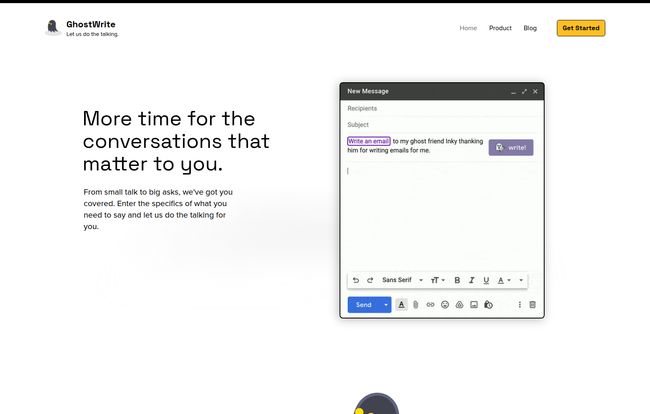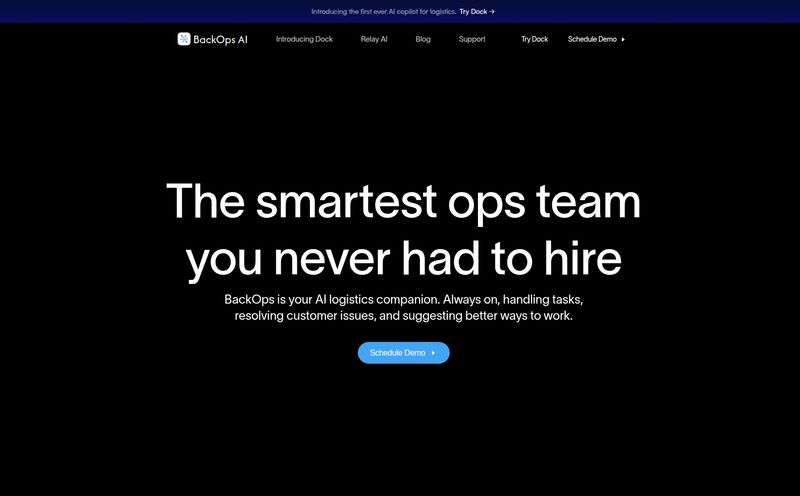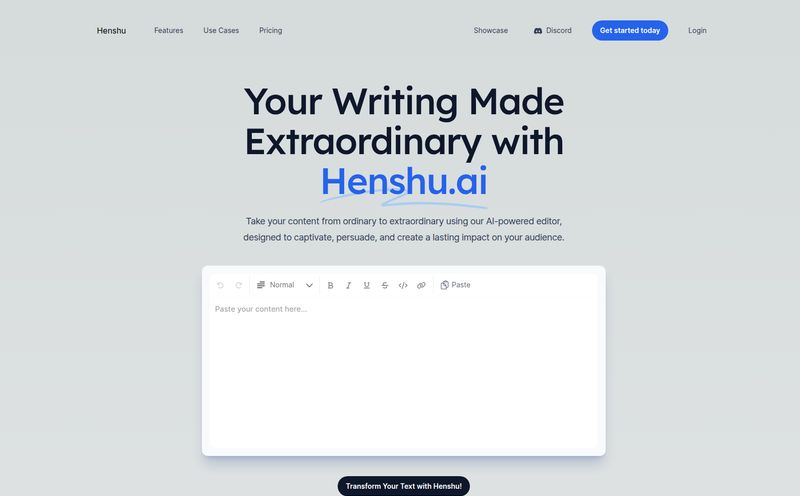The inbox. It never sleeps. It's a relentless digital beast that demands constant feeding, and frankly, I'm tired of being on the menu. We’ve all been there—staring at a blank “Compose” window, trying to find the perfect words for a follow-up, a client pitch, or even just a polite way to say “please stop emailing me.” The dream of Inbox Zero feels more like a mythical legend than an achievable goal these days.
So, whenever a new tool pops up promising to slay this dragon, my ears perk up. Enter Ghostwrite, an AI email writing assistant with a cute little ghost for a mascot and a big promise: “More time for the conversations that matter to you.”
Another AI productivity tool, you say? I know, I know. The market's getting crowded. But something about Ghostwrite’s straightforward approach caught my eye. It doesn’t claim it will take over your life; it just wants to help you do the talking. So, I decided to peek behind the curtain and see if this friendly phantom is the real deal or just more digital smoke and mirrors.
First Impressions and What Ghostwrite Claims to Do
Hopping onto the Ghostwrite homepage is a clean, no-fuss experience. Big, bold text, a simple animation showing the tool in action, and that adorable ghost. The core message is crystal clear: this is about efficiency. It’s about offloading the mental work of crafting emails so you can focus on the substance of the conversation.
The idea is simple. You give Ghostwrite a prompt—a quick, messy instruction like, “tell my boss I finished the report and ask what to work on next”—and it drafts a professional, coherent email for you. It’s designed to handle everything from “small talk to big asks,” which is a pretty wide net to cast.

Visit Ghostwrite: AI Email Writing Assistant
Basically, it’s an AI-powered ghostwriter for your daily communications. An intriguing proposition for anyone who sees their time get sucked away by the black hole of their inbox. And I mean, who doesn't?
How Does This Spooky Little Assistant Actually Work?
Okay, so it’s not actually magic (though sometimes it feels close). Ghostwrite operates on a foundation of artificial intelligence, but it’s more like a super-smart intern than an all-knowing oracle. You are still the boss.
The process is straightforward. You provide the raw materials—the purpose of the email, the key points, the desired tone—and the AI gets to work. Its core features revolve around a few key functions:
- AI-Powered Generation: This is the main event. You give it a prompt, it gives you a draft. The quality of your prompt directly influences the output, which is a classic rule for any AI tool. “Garbage in, garbage out” still applies, so a little bit of direction goes a long way.
- Customizable Outputs: You’re not stuck with the first draft. You can ask for revisions, change the tone to be more casual or more formal, or tweak the length. It's an iterative process.
- Personalized Style: This is where it gets interesting. Ghostwrite claims to learn your unique writing style over time. The more you use it and edit its suggestions, the more it starts to sound like you. This is the holy grail for personalization, moving beyond the generic, slightly robotic tone that plagues so many AI writers.
- Editing and Approval: This is a non-negotiable step, and I'm glad they seem to build the workflow around it. You always get the final say. You can edit the text directly before hitting “Send,” ensuring nothing weird or off-brand slips through the cracks.
Think of it less as a self-driving car and more as a top-of-the-line cruise control system. It handles the steady, boring parts, but you still need to keep your hands on the wheel.
The Good, The Bad, and The Spooky
No tool is perfect, especially in the fast-moving world of AI. After kicking the tires, here’s my breakdown of where Ghostwrite really shines and where you might encounter a few bumps in the night.
Where Ghostwrite Shines (The Good Stuff)
Honestly, the biggest win here is the time savings. And not just the raw minutes, but the mental energy. I used it to draft a few tricky follow-up emails to potential partners, a task that usually involves me pacing around my office, agonizing over every word choice. With Ghostwrite, I gave it a simple prompt, got a solid 80% solution in seconds, made a few tweaks to add my personal flair, and sent it off. What used to take 15 minutes of my brainpower took about two.
It's also a fantastic cure for writer's block. We’ve all been there—that cursor just blinking, mocking you. Ghostwrite is brilliant at just getting something on the page. A draft, even an imperfect one, is infinitely easier to edit than a blank screen is to fill. This is a massive confidence booster, especially for people who aren't natural writers or who have to communicate frequently in a non-native language.
The personalization aspect is also a huge plus. The idea that it can move beyond generic templates and adopt my phrasing and cadence is what separates a decent tool from a great one. It’s a bit like training a new assistant—it takes a little time, but the payoff is having support that genuinely understands how you operate.
The Ghost in the Machine (Potential Hiccups)
Now, let's be realistic. This isn't a magical email fairy. One of the cons is that it “requires user input,” which is kind of like saying a car requires a driver. Of course it does! But the point is valid: the quality of the output is directly tied to the quality of your prompt.
More importantly, you have to edit the output. I can't stress this enough. AI can be weird. It can be overly formal, miss subtle social cues, or just phrase something in a way a real person never would. Sending an AI-generated email without proofreading is like playing Russian roulette with your professional reputation. Always, always give it a quick read-through.
And then there's the data question. The tool improves by learning from user data. For most day-to-day emails, this is probably fine. But if you're in a field that handles highly sensitive or confidential information, like law or healthcare, you need to be very critical of any third-party tool that reads your communications. Always check the privacy policy—not just for Ghostwrite, but for any AI tool you consider using. Its a good habit to have.
So, How Much Does This Ghost Cost?
This is where things get a bit mysterious. I clicked around, hunted for a pricing page, and... poof! I was met with a 404 error. The page was a ghost.
Now, this could mean a few things. It's a common strategy for new SaaS companies still in beta or refining their pricing tiers. They might be focusing on custom enterprise plans first before rolling out public pricing. Or perhaps they're planning a freemium model and just haven't finalized the details. It's hard to say for sure.
My advice? Head to their site directly. By the time you read this, the page might be live. If not, there's usually a contact or signup form where you can get more information. The lack of public pricing is a bit of a hurdle, but not necessarily a red flag in this stage of a product's life.
Who is Ghostwrite Really For?
After playing around with it, I see a few key people who could really benefit from having a friendly ghost in their email client:
- The Overwhelmed Professional: If your job involves a high volume of email and you feel like you're constantly just “managing” your inbox instead of doing your actual job, this could be a lifesaver.
- The Small Business Owner: You’re the CEO, the sales team, and the customer support rep all in one. Ghostwrite can help you maintain professional and timely communication without hiring a dedicated assistant.
- The Hesitant Writer: If you dread writing emails, second-guess every sentence, and spend way too much time in your drafts folder, this tool can provide the starting point you need to communicate confidently.
Who is it probably NOT for? If you only send a handful of emails a week, the time savings might be negligible. And, as mentioned, if your work is governed by strict data privacy regulations like HIPAA, you’ll need to do some serious due diligence before letting an AI handle your correspondence.
Frequently Asked Questions about Ghostwrite
How does Ghostwrite learn my writing style?
Ghostwrite learns through your interaction with it. As you use the tool and edit its suggestions to better match your voice—for instance, changing formal phrases to more casual ones or adding your favorite sign-offs—the AI model begins to recognize these patterns. Over time, its initial drafts will more closely resemble something you would have written yourself.
Is Ghostwrite free to use?
As of this writing, public pricing information isn't available on their website. Many new AI tools offer a free trial, a freemium model with limited features, or tiered subscription plans. It's best to check the official Ghostwrite website for the most current information on pricing and trials.
Can I use Ghostwrite with Gmail and Outlook?
While the website doesn't specify integrations, most AI email assistants are designed to work as browser extensions or add-ins for major email clients like Gmail and Outlook. Given its focus on practicality, it's highly likely that it integrates with the most popular platforms.
What makes Ghostwrite different from just using ChatGPT?
The key difference is integration and personalization. While you could copy-paste from ChatGPT, Ghostwrite is designed to live inside your email workflow, making it much more efficient. Furthermore, its focus on learning your specific writing style over time aims to provide more personalized and less generic outputs than a general-purpose model like ChatGPT would.
Do I still need to proofread the emails Ghostwrite writes?
Absolutely. Yes. 100%. AI is a powerful assistant, but it is not infallible. It can misinterpret context, make factual errors, or use awkward phrasing. Always treat the AI's output as a first draft that requires a final human review before sending.
My Final Verdict: Should You Hire This Ghost?
So, is Ghostwrite the answer to all our email prayers? Maybe not all of them, but it’s a seriously promising step in the right direction. It's not about replacing you; it's about augmenting you. It’s a tool that hands you back one of the most precious resources we have: time and mental bandwidth.
By taking on the grunt work of drafting, it frees you up to think strategically about your communication, to build better relationships, and to focus on those conversations that genuinely matter. It's a smart assistant that, with a little training, could become an indispensable part of your productivity toolkit.
If you're feeling haunted by your inbox, giving Ghostwrite a try seems like a no-brainer. It might just be the friendly spirit that finally helps you banish those email demons for good.
Reference and Sources
- Ghostwrite Official Website
- The Emerging Art of Writing Prompts - A TechCrunch article discussing the importance of good prompting for AI.



